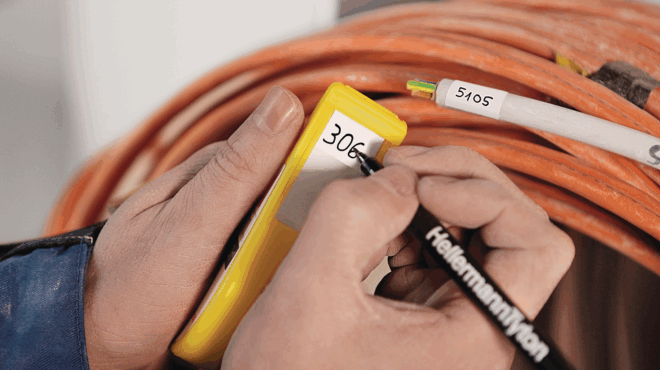
Fibre Optic Networks and 5G Networks for New Technologies
We provide an overview of individual components in fibre optic networks and address the following questions: What are the current development stages? How are fibre optic networks connected to existing networks? And what potential does fibre optic technology offer for new industrial sectors?
Table of contents
- Mobile communications generations
- The technical foundations of 5G
- Three networks for different applications
- 5G and fibre-optic networks: component overview
- Expansion stages of the fibre optic network: Three paths (currently) lead to data transmission
- Cornerstone of new developments - poor development with "lame" lines
- FAQ on the 5G mobile network
New technology is founded on new technologies. Whether it is in terms of networking machines in industry (for example IoT) or for high-speed data transmission. The 5G network requires new communication and development standards. To realize this progress, high-performance networks are needed – based on fibre optic technology, for example.
Currently, fibre optic networks are the adequate technology to provide the necessary transmission rates. And for the new technological standard, existing copper lines must be successively dismantled, and fibre optic networks built.
Mobile communications generations
5G is already the fifth generation of mobile communications. Only the first generation was analog; from the second generation onward, digital technology was used. The key feature of each new mobile communications generation was the increased data rate and the associated increase in capacity. In addition, other technical parameters such as the response time of the overall system improved over time, as the following table shows:
| Mobile communications Generation | Designation of mobile communications technology | Advantages compared with predecessor |
|---|---|---|
| 1G | Natel C | |
| 2G | GSM (Global System for Mobile Communication) | Digital technology, better use of frequencies |
| 3G | UMTS (Universal Mobile Telecommunication System) | Larger bandwidth (5 MHz), transmission speed 40 times higher, primarily for mobile data use |
| 4G | LTE (Long-Term Evolution) | Data rate 10 to 20 times higher (100-300 Mbps), allows use of existing UMTS infrastructure, therefore also called 3.9 G |
| 5G | NR (New Radio) | High data rates (from 1 Gbps), short loading times (1 ms), high connection densities (100,000 per square kilometer), possibility of providing subnetworks |
The technical foundations of 5G
In the preceding networks LTE (4G) and UMTS (3G), the number of mobile stations depended heavily on population density. The network architecture of the 5th mobile communications generation on the other hand, focuses more on the user and his or her local requirements. Here are a few examples:
- In a commercial area, a broadband network with high data rates is needed.
- On a traffic route, a fast and reliable network with short response times is required.
- On a factory floor, it is crucial that a large number of devices and people are networked together.
What also has to be considered from a technical point of view when expanding the network are the coverage requiremenst of the frequency ranges. Initially, area-wide partial 5G improvements based on 4G networks are conceivable. Parallel operation of 4G and 5G networks is unavoidable, as the rollout will take place in stages.
Three networks for different applications
For the 5G network, a distinction is made between three application areas, which entail specific challenges and technical framework conditions:
- Ultra-fast mobile broadband: in terms of mobile Internet use, high data rates and large capacity are most important.
- Communication between machines: Machine-to-machine (MGM) communication focuses on low energy consumption.
- High-reliability network: Because they are considered ultra-fast and reliable, developments toward connected driving or autonomous public transport, for example, are being driven forward.
What does this mean? In order to meet the above-mentioned requirements, a highly flexible mobile communications network of the future has been developed in the form of 5G.
5G and fibre-optic networks: component overview
To be able to ensure data transmission in the current situation, new electronic components are needed on the one hand to form new networks – but also components that enable conversion from new to old lines (copper, for example).
Components for data transmission in fibre optic networks:
- Fibre optic cables: Optical fibres for data transmission consist of a core, a jacket, and a sheath to protect against mechanical forces (for example, pressure). The designation is made according to the core and cladding diameter: a typical single-mode optical fibre is dimensioned with a core diameter of nine µm and a cladding diameter of 125 µm. Other fibre optic categories: Multimode (step index or gradient index) and NZDS fibre, low water peak and PM fibre, and bend insensitive fibre.
- FO connectors: are used for detachable connection of optical fibres and technical components. An example of this is the Hirschmann brand fibre optic connectors, which are suitable for plastic fibre optic cables with an outer sheath diameter of 2.2 millimetres.
- FO converters: are used in network technology to connect individual network segments (for example twisted pair cable, coaxial cable or FO cable). By using a media converter, data can be transferred from one medium to another.
Expansion stages of the fibre optic network: Three paths (currently) lead to data transmission
A distinction is made between three expansion stages of the fibre optic connection: In simplified terms, the fibre optic connection starts at an exchange (of the respective network operator) and leads in the direction of the recipient (e.g., end user/customer). The fibre optic connection can be distributed in different ways – the umbrella term for this is FTTx.
The term FTTx generally describes the availability of the optical fibre up to a specific distribution point – “Fibre to the …”. The “x” in this context serves as a placeholder for the other expansion types (for example, “H” for “home” / “B” for “building” / “C” for “curb”).
FTTC fibre optic connection: 5G from the server to the front door
At around 80 percent, FTTC connections are (still) the most widespread expansion stage of fibre-optic networks in Germany. Conversely, this means that less than 20 percent of fibre optic lines reach into the home.
In fibre-to-the-curb networks, the optical fibres or fibre optic cables run from a local exchange to the property boundary. At this point, the signal from the fibre optic technology must be transferred to a copper cable – how does this work? An optical fibre media converter (FO media converter) converts the optical light signals so that they can be transmitted over copper lines.
Addendum: By integrating a fibre optic converter, other network components can also be interconnected (for example, routers, switches or Ethernet).
FTTB fibre-optic connection: 5G right into the home
In the case of FTTB connections, the fibre optic cables extend into the home – the existing copper cables are then used again in the building. In most cases, the distribution system is located in the basement of the house. From there, the lines run to the individual residential units.
FTTH fibre optic connection: 5G network at home / at work
The third expansion stage extends into the home. From the exchange, however, the fibre optic cables do not lead directly into the home or into each individual room. Via the respective cable branch or via a multifunctional housing, the optical fibres are laid into the corresponding area of the property. In the process, optical network units (ONU) in the multifunction housings shorten the data transmission over the lower-performance copper network.
Addendum: If the fibre optic network extends to the apartment or to the respective location, the use of a fibre optic modem is required. The fibre optic cabling then leads from the exchange to a fibre optic outlet. The modem is connected to this via a fibre optic cable. Finally, the fibre optic modem is connected to the router via a LAN cable.
Cornerstone of new developments – poor development with “lame” lines
The development of network technologies and their integration in everyday life is an essential factor for the further expansion of modern technologies and innovative engineering. It has been known for decades that conventional copper lines cannot meet the demands of a performance-efficient data infrastructure.
In order to be able to cope with the increasing exchange of data, it is necessary to build an advanced and expandable fibre optic network throughout the country. Numerous components are required for the construction of the networks – at Bürklin Elektronik you will find the most diverse products (fibre optic components) from the leading manufacturers for the construction of modern fibre optic networks!
FAQ on the 5G mobile network
How big are the new base stations? Will the radio cells be smaller?
The previous large mobile towers will gradually give way to diverse antennas for small cells. In this context, 5G mobile network providers are relying on more but smaller installations at more locations, especially at the very high frequencies. The small cells are roughly the size of a pizza box.
Which frequency ranges and which modulation types are used?
The frequency ranges between 700 megahertz and 2.6 gigahertz have already been used for third- and fourth-generation mobile communications – this also works in principle for 5G. However, the high bandwidths of some 5G applications require additional frequencies:
- 3.4 to 3.7 gigahertz for nationwide use by public mobile networks
- 3.7 to 3.8 gigahertz for local non-public mobile networks with applications in agriculture, Forestry, Business, and Industry
- 24.25 to 27.5 gigahertz for small cell networks or highly directional radio links between two stations (specifically for Germany)
- 71 to 76 and 81 to 86 gigahertz for supplementary E-band
The following two modulation types are primarily used:
- Quadrature phase shift keying:
This lowest order modulation format provides the slowest data throughput. However, it offers the most robust connection. Ideal for low signal levels or high interference. - Quadrature amplitude modulation:
This modulation type can be used to increase data throughput. For 5G mobile communications systems, 16QAM, 64QAM and 256QAM formats are used.
Is the transmission power of the base stations reduced?
That depends entirely on the application. The millimeter wave frequency requires the use of small cells in various applications. While the overall frequency is higher than ever before, the signals of this millimeter wave are weaker and consequently only reach over shorter distances. In 5G-enabled areas, therefore, small cell stations often need to be placed in order for the signals to reach users at all.
What is the data rate?
Under ideal conditions, 5G will achieve data transmission speeds of up to ten gigabits per second in the future. Twenty times more than with LTE.
What are the requirements for components such as coaxial connectors or antennas?
There are specific aspects that various components should have in terms of mobile communications technology:
- a compact design for space and weight savings
- contact surfaces that are protected against damage even when unplugged
- a robust design that can withstand even harsh environmental conditions
Product tip: The connectors in Telegärtner’s IQ family are optimized for various corrugated sheathed cables. They deliver particularly good PIM values regardless of torque and coupling mechanism. In addition, they offer screw, hand-screw, and push-pull options with the same socket.
Are there any new designs for the antennas?
The new heptaband antennas may outwardly resemble their predecessors. Inside them, however, a lot has changed technically. Previous omnidirectional antennas radiated their signal with little aim in the 360-degree range. The heptaband systems, on the other hand, form sectors for specific areas and make it possible to provide users with various services in a targeted manner.
Incidentally, the housing is made of fiberglass-reinforced plastic and is known as a radome. In addition, the new antennas can cover seven frequency bands at once and are thus ideally equipped to meet future requirements.
How are sites for base stations selected?
Base stations for mobile communications must be planned very carefully for economic reasons alone. What is more, in addition to technical and structural conditions, the protection of the local landscape and nature should also be taken into account.
The operators’ goal is to supply areas with power evenly and optimally at the same time. For purely functional reasons, therefore, a single base station in the center often makes the most sense in smaller communities, for example.
On the outskirts, the base stations would perhaps be less conspicuous. However, as soon as the placement means that the entire area can no longer be supplied with the same power, additional stations may even be needed. Whether this approach would meet with more acceptance and be economical at the same time remains to be seen.
Whenever 5G will be installed nationwide: Bürklin Elektronik already provides various products for telecommunication technology in its online store, ranging from connectors specifically for mobile radio applications to multi-chip modules.




